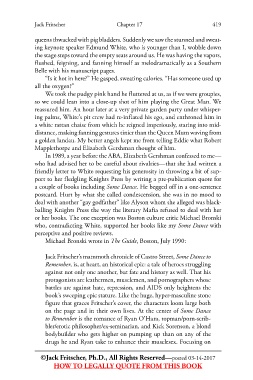Page 437 - Gay Pioneers: How DRUMMER Magazine Shaped Gay Popular Culture 1965-1999
P. 437
Jack Fritscher Chapter 17 419
queens thwacked with pig bladders. Suddenly we saw the stunned and sweat-
ing keynote speaker Edmund White, who is younger than I, wobble down
the stage steps toward the empty seats around us. He was having the vapors,
flushed, feigning, and fanning himself as melodramatically as a Southern
Belle with his manuscript pages.
“Is it hot in here?” He gasped, sweating calories. “Has someone used up
all the oxygen?”
We took the pudgy pink hand he fluttered at us, as if we were groupies,
so we could lean into a close-up shot of him playing the Great Man. We
reassured him. An hour later at a very private garden party under whisper-
ing palms, White’s pit crew had re-inflated his ego, and enthroned him in
a white rattan chaise from which he reigned imperiously, staring into mid-
distance, making fanning gestures tinier than the Queen Mum waving from
a golden landau. My better angels kept me from telling Eddie what Robert
Mapplethorpe and Elizabeth Gershman thought of him.
In 1989, a year before the ABA, Elizabeth Gershman confessed to me—
who had advised her to be careful about rivalries—that she had written a
friendly letter to White requesting his generosity in throwing a bit of sup-
port to her fledgling Knights Press by writing a pre-publication quote for
a couple of books including Some Dance. He begged off in a one-sentence
postcard. Hurt by what she called condescension, she was in no mood to
deal with another “gay godfather” like Alyson whom she alleged was black-
balling Knights Press the way the literary Mafia refused to deal with her
or her books. The one exception was Boston culture critic Michael Bronski
who, contradicting White, supported her books like my Some Dance with
perceptive and positive reviews.
Michael Bronski wrote in The Guide, Boston, July 1990:
Jack Fritscher’s mammoth chronicle of Castro Street, Some Dance to
Remember, is, at heart, an historical epic: a tale of heroes struggling
against not only one another, but fate and history as well. That his
protagonists are leathermen, musclemen, and pornographers whose
battles are against hate, repression, and AIDS only heightens the
book’s sweeping epic stature. Like the huge, hyper-masculine stone
figure that graces Fritscher’s cover, the characters loom large both
on the page and in their own lives. At the center of Some Dance
to Remember is the romance of Ryan O’Hara, topman/porn-scrib-
bler/erotic philosopher/ex-seminarian, and Kick Sorenson, a blond
bodybuilder who gets higher on pumping up than on any of the
drugs he and Ryan take to enhance their musclesex. Focusing on
©Jack Fritscher, Ph.D., All Rights Reserved—posted 03-14-2017
HOW TO LEGALLY QUOTE FROM THIS BOOK

